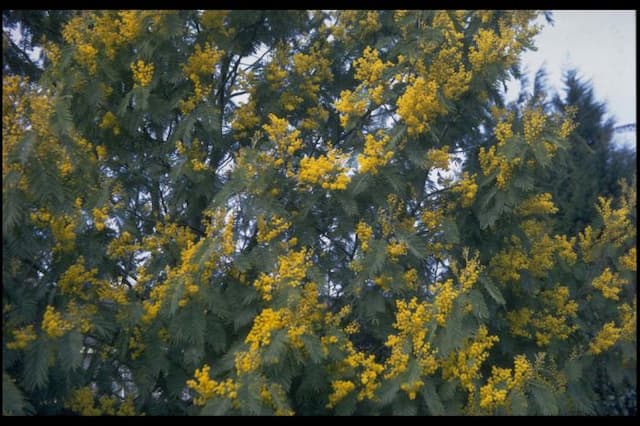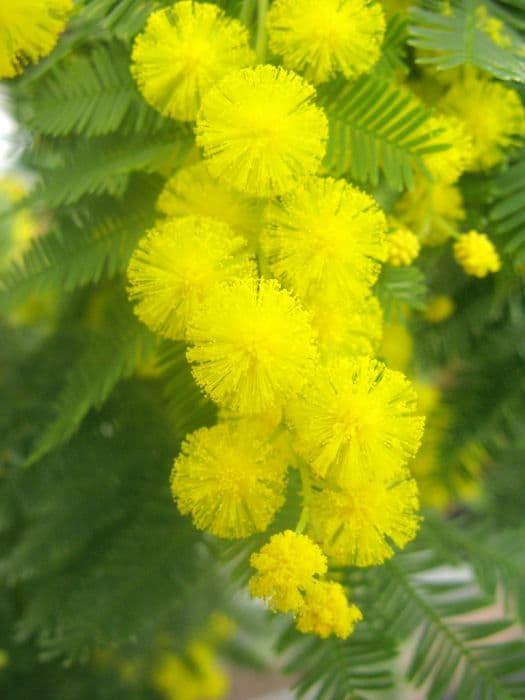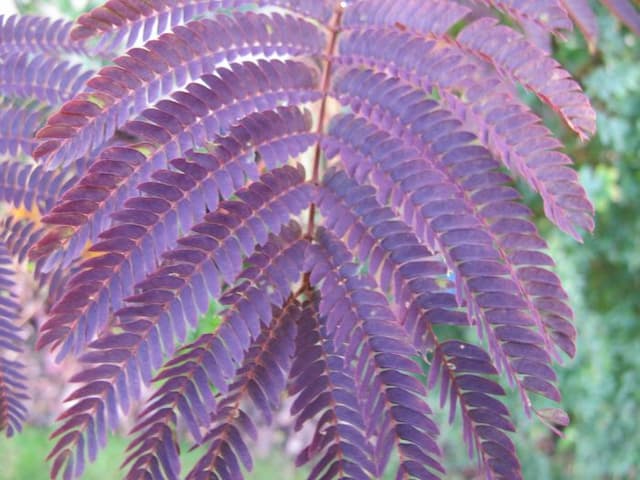Sweet pea Lathyrus odoratus 'Monty Don'

ABOUT
Lathyrus odoratus 'Monty Don', commonly known as sweet pea 'Monty Don', is a flowering plant renowned for its alluring fragrance and striking blossoms. This cultivar typically presents a palette of deep, rich maroon flowers, which often exhibit a velvety texture. The petals are beautifully arranged with a standard or banner petal at the top, adorned with ruffled or waved edges, flanked by wings on the sides, and a keel at the bottom enclosing reproductive parts. The foliage of the sweet pea 'Monty Don' consists of pinnate leaves, which are usually composed of one or more pairs of leaflets coupled with a tendril that spirals around supports to help the plant climb. The leaves are generally light to medium green and have a slender, elongated shape. Flowers bloom in clusters, creating an impressive display of color. The stems of the sweet pea are slender and wiry, capable of climbing with the support of tendrils that reach out to secure the plant as it grows. The tendrils allow the sweet pea to twine around various supports, making it an excellent choice for trellises or for growing along fences. The overall form is delicate and airy, giving the plant an elegant appearance amidst its surroundings.
About this plant
 Names
NamesFamily
Fabaceae.
Synonyms
Sweet Pea, Everlasting Pea, Perennial Pea, Sweetpea.
Common names
Lathyrus odoratus
 Toxicity
ToxicityTo humans
The plant commonly known as sweet pea, including the variety 'Monty Don,' can be toxic if ingested. Although it is not commonly associated with human poisoning, consuming the seeds or plant material of sweet pea can potentially lead to a condition known as lathyrism. Symptoms of lathyrism include weakness and paralysis of the lower limbs, and if severe, it can lead to convulsions and even death due to respiratory failure. Consumption, especially in large quantities, should be avoided.
To pets
Sweet pea, which includes the variety called 'Monty Don,' is also toxic to pets. Ingesting significant quantities of this plant can cause symptoms similar to those in humans, including lethargy, weakness, and possibly seizures. The seeds are particularly toxic. If a pet consumes sweet pea, it is vital to seek veterinary assistance as soon as possible to manage the potential toxicity and prevent more severe consequences.
 Characteristics
CharacteristicsLife cycle
Annuals
Foliage type
Deciduous
Color of leaves
Green
Flower color
Varies
Height
6 feet (1.83 meters)
Spread
1 foot (0.30 meter)
Plant type
Climber
Hardiness zones
2
Native area
Mediterranean
Benefits
 General Benefits
General Benefits- Aesthetic Appeal: Adds visual interest to gardens with its vibrant blooms and sweet scent.
- Attracts Pollinators: Invites beneficial insects like bees and butterflies, which are vital for pollination.
- Easy to Grow: Known for being easy to cultivate, making it suitable for gardeners of all skill levels.
- Versatility: Can be used in borders, containers, and as cut flowers, offering various options for garden design.
- Climbing Habit: Ideal for vertical gardening as it can climb trellises, fences, and other supports, saving space.
- Edible Flowers: Blossoms are sometimes used in culinary applications, adding color and taste to dishes.
- Seasonal Interest: Blooms in the spring and summer, providing seasonal color to the garden landscape.
- Heritage Variety: Carries historical significance and presents an opportunity to grow heirloom plant varieties.
 Medical Properties
Medical PropertiesThis plant is not used for medical purposes.
 Air-purifying Qualities
Air-purifying QualitiesThis plant is not specifically known for air purifying qualities.
 Other Uses
Other Uses- Cut Flowers: Sweet pea 'Monty Don' blooms are extensively used for cut flower arrangements due to their fragrance and variety of colors.
- Edible Flowers: While not commonly eaten, the flowers of the sweet pea can be used as a colorful, albeit mildly flavored, addition to salads and desserts.
- Companion Planting: Sweet peas can be used in the garden to climb over and support other more fragile plants or to provide a fragrant backdrop.
- Natural Dyes: The petals of sweet pea flowers can be used to create natural dyes for fabrics or art projects.
- Educational Tool: Sweet peas are often used in educational settings to teach children about plant growth and gardening due to their easy cultivation and rapid growth.
- Garden Aesthetics: Garden designers use sweet peas to add height and dimension to garden beds and borders.
- Species Preservation: Some gardeners grow heirloom varieties of sweet peas like ‘Monty Don’ to help preserve the genetic diversity of the species.
- Bee and Butterfly Attractor: The sweet scent and vivid colors of sweet peas attract pollinators, contributing to the health of the garden ecosystem.
- Crafts: Dried sweet pea flowers can be used in potpourris or pressed flower crafts, such as bookmarks and greeting cards.
- Photography Subject: Due to their attractive appearance, sweet peas are often used by photographers as a subject for floral and garden photography.
Interesting Facts
 Feng Shui
Feng ShuiThe sweet pea is not used in Feng Shui practice.
 Zodiac Sign Compitability
Zodiac Sign CompitabilityThe sweet pea is not used in astrology practice.
 Plant Symbolism
Plant Symbolism- Pleasure: Lathyrus odoratus, commonly known as Sweet Pea, symbolizes pleasure and delights due to its sweet fragrance and enchanting flowers.
- Goodbye: Sweet Pea also represents farewells or goodbyes, as it was traditionally given to someone who was leaving or departing.
- Thankfulness: Gifting Sweet Peas can mean a show of thanks, making them a way to express gratitude.
- Delicate Pleasures: The delicate appearance of its blooms is often associated with enjoying the simple, fleeting pleasures in life.
- Blissful Pleasure: Because of their intoxicating scent, Sweet Peas are associated with blissful pleasure or pure enjoyment.
 Water
WaterSweet peas, including the 'Monty Don' variety, prefer consistent moisture. It is important to water them thoroughly on a weekly basis, providing about one inch of water each time. During periods of drought or extreme heat, you may need to water them more frequently, possibly every few days. Check the soil moisture level regularly; it should be moist but not waterlogged. Adjust your watering schedule based on rainfall and temperature, ensuring that the plants receive a total of about 1-1.5 gallons of water per week.
 Light
LightSweet peas like 'Monty Don' thrive best in full sun to partial shade. An ideal spot for these sweet peas is one where they can enjoy at least six hours of sunlight daily. However, in extremely hot climates, they benefit from afternoon shade to prevent overheating and wilting.
 Temperature
TemperatureSweet peas, such as 'Monty Don', prefer cooler temperatures and can generally tolerate conditions as low as 25°F for short periods. Frost may damage the flowers but the plant can survive occasional frosts. The ideal growing temperature range for sweet peas is between 55°F and 65°F. They will start to suffer when temperatures consistently rise above 80°F.
 Pruning
PruningPruning sweet peas, including the 'Monty Don' variety, encourages bushier growth and more blooms. Pinch out the growing tip once the plant has reached about 4-6 inches in height. Throughout the blooming season, regularly deadhead spent flowers to promote continued blooming. Prune any dead or yellowing leaves to maintain plant health and appearance.
 Cleaning
CleaningAs needed
 Soil
SoilSweet peas prefer rich, well-draining soil with a pH between 6.0 and 7.5. A good mix for sweet peas would include garden soil, compost, and a bit of perlite or vermiculite to enhance drainage. Regularly adding organic matter will benefit the plant's vigorous growth.
 Repotting
RepottingSweet peas, being annuals, do not typically require repotting. They are sown directly into their permanent position in the garden or a sufficiently sized container where they will live out their life cycle.
 Humidity & Misting
Humidity & MistingSweet peas enjoy moderate humidity levels. They are not overly sensitive to humidity fluctuations, making them suitable for most outdoor garden environments without needing special humidity adjustments.
 Suitable locations
Suitable locationsIndoor
Place sweet peas in a bright spot, provide a trellis for support.
Outdoor
Plant in full sun, enriched soil, with a support structure.
Hardiness zone
2-11 USDA
 Life cycle
Life cycleLathyrus odoratus 'Monty Don', commonly known as sweet pea 'Monty Don', begins its life as a seed, usually sown in late winter or early spring. After germination, the seedling emerges and develops into a young plant, producing a stem and leaves as it establishes a root system. As it matures, the plant climbs using tendrils and produces more foliage, followed by the development of distinctive fragrant flowers, typically in late spring or early summer. After pollination, often by bees and other insects attracted by the flowers' scent and color, the sweet pea sets seed pods. These pods mature, eventually drying and releasing seeds for the next generation. The plant is annual, completing its lifecycle within one growing season and then dying, leaving behind seeds to start the cycle anew the following year.
 Propogation
PropogationPropogation time
Spring
Sweet pea 'Monty Don' is typically propagated through seeds. The most popular method involves sowing seeds directly in the ground or starting them indoors. For best results, seeds should be planted in late winter or early spring. Before planting, it is beneficial to nick the seed coat with a file or to soak the seeds in water for 24 hours to enhance germination. Sown about an inch deep (2.54 cm), with a spacing of about 2 to 3 inches (5 to 7.6 cm), the seeds will germinate in 10 to 14 days in a soil temperature around 55 to 65 degrees Fahrenheit (13 to 18 degrees Celsius). Once seedlings have grown strong enough, they can be transplanted outside after any risk of frost has passed. It’s important to provide support for climbing as sweet peas are vigorous growers and will need something to twine around as they grow.









